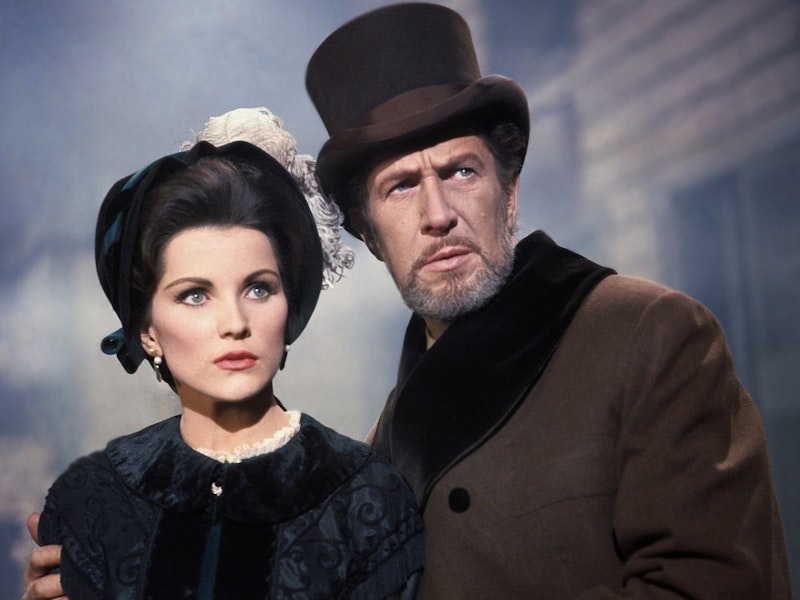In 1963, after producing and directing five films based on the works of Edgar Allan Poe, Roger Corman wanted to do something different. His next movie was an adaptation of a tale by a different horror writer. But American International Pictures, who financed him, wanted to ride the success of the Poe films. They changed the new movie’s title, and had star Vincent Price recite a few lines of Poe’s poem “The Haunted Palace” as a framing device. So The Haunted Palace went out into the world. But it isn’t a Poe adaptation in any meaningful sense. Instead, it’s an effective adaptation of “The Case of Charles Dexter Ward” by H.P. Lovecraft.
It opens in the 18th century, in the small Massachusetts town of Arkham, when a mob besieges local occultist John Curwen (Price) and interrupts his scheme to sacrifice a hypnotized maiden. The mob kills Curwen, but he lays a curse on Arkham. Around 100 years later, his descendant Charles Dexter Ward (Price again) arrives with his wife Anne (Debra Paget) to claim Curwen’s now-abandoned mansion. The townsfolk, who’ve seen over a century of birth defects afflicting the descendants of Curwen’s enemies, are suspicious. And there are sinister people about, including a man named Simon Orme (Lon Chaney Jr.) who claims to be a caretaker of the old Curwen mansion. The local doctor warns the Wards of the nefarious influence of an evil book called the Necronomicon, but that’s not enough to save them from the evil spirit of Curwen and the terrible things in the basement.
Lovecraft was a cult author in more than one sense when Corman made this film, still an obscure figure more than 25 years after his death. This was the first time his mythos made it to the screen, the first mention in cinema of Yog-Sothoth and Cthulhu. Scripted by the well-regarded horror writer (and frequent Twilight Zone contributor) Charles Beaumont, the story’s far different in plot from Lovecraft’s tale but faithful in spirit to its concept and to the overall Cthulhu mythos.
With Corman’s classical direction and lovingly gothic lighting, set and art design, the movie has the feel of a Universal horror film themed around Lovecraft: the forbidding building, the sullen villagers, the lurking terror. The old-fashioned acting echoes that, with familiar veterans like Chaney and Elisha Cook Jr. appropriately broad. Price handles the dual role of Curwen and Ward well, and even manages to make the confusion and self-doubt of Ward more interesting than the pure evil of Curwen.
If the movie looks back to the Universal films, it also looks ahead to the 21st century’s fascination with Lovecraft and cosmic horror, and yet it’s perfectly of its moment. You can see the early-1960s in the film: the birth defects Curwen’s curse brings on the village may glance back to Tod Browning’s Freaks, but also reminds us of atom-age fears of mutation. More specifically, it evokes the specter of thalidomide, sold in some countries as a tranquilizer and cure for morning sickness but which in 1961 was proved to cause fetal malformations.
The movie has a different rhythm than modern horror, with no jump scares but many slow builds to dreadful realizations. Here as elsewhere in the Poe cycle, Corman relies on favorite scary-movie devices: insert shots of spiders and corpses and such don’t carry the weight they once did, but do create some kind of atmosphere. More successful is the old Val Lewton trick of having the protagonist walk into a shadowy place with unknown dangers. Corman likes the effect of bringing a stranger, an outsider, into the small gothic world of a sprawling house or mist-shrouded village—rather than try to set up a credible realist world, Corman encourages us to follow a protagonist into his budget-conscious world of horror.
That’s particularly effective in this case, as the slightly-surreal vision of the town of Arkham contrasts with the shadowed Curwen mansion and its props familiar from previous films in the Poe cycle. As dreamlike as the cobbled streets of Arkham may look, the set still conjures up the sense of a New England port. The idea of the place comes across, and the period setting means we don’t doubt the isolation and difficulty of travel.
The movie doesn’t always work—the cemetery is a notably cheap set. And there are moments at the climax when the film loses control, moving the action in and out of the Curwen house erratically and letting a thread or two of plot go untied. Given the sexual implications of the final revelations, you wonder if there were some editorial restrictions imposed on Corman.
The movie is slightly more overtly sexualized than the earlier Poe films. Curwen wants to rape Ward’s wife, an idea nowhere in Lovecraft but one that fits in both with the logic of Curwen’s occult powers and with his desire to mate humans with Elder Gods. At the same time, Curwen tries to gain and then maintain control over the physical form of Ward, meaning that unlike most horror movies the villain’s focused on a male body and not a female one.
It’s enough of a subtext to give a frisson of horror, and give something to ponder as the actual story pulls you in. As a first attempt at adapting Lovecraft, the movie’s a reasonable success. The film’s b-movie ethos isn’t much like what Lovecraft was trying to do in his prose. But as pulp art, it’s not unlike Lovecraft’s fiction: art made outside respectable channels, art made with an eye on the lurid, but art that succeeds.

